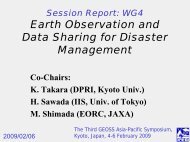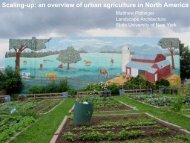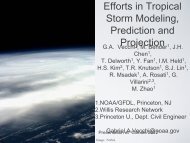High resolution CAM5.1 simulations
High resolution CAM5.1 simulations
High resolution CAM5.1 simulations
- No tags were found...
You also want an ePaper? Increase the reach of your titles
YUMPU automatically turns print PDFs into web optimized ePapers that Google loves.
<strong>High</strong> <strong>resolution</strong> <strong>CAM5.1</strong><strong>simulations</strong>Michael Wehner, Kevin Reed, Prabhat, Surendra Byna,Bill Collins, Fuyu Li, Travis O’Brien,Julio Bacmeister, Andrew Gettelman
0.25 o <strong>CAM5.1</strong>• NCAR Community Atmospheric Model Version 5.1–1979-2005 is complete. 100TB of output.–AMIP protocols, HadISST–Standard release version 5.1 with time dependent prescribedaerosol forcing. Input deck from Julio. No further tuning–Observed ozone, CO 2 , solar forcing–Principal motivations is to quantify hurricane statistics in achanging climate.• Follow on to a CAM2.2 study at 0.5 o–We are also interested in other extreme weather statistics.• Extratropical cyclones, atmospheric rivers, extreme precip.–Much analysis remains.
Embed movie here
Performance details• Integrations performed on hopper.nersc.gov– CRAY XE-6• Used 7680 processor cores–6 OpenMP threads–1280 MPI tasks–185,000 processor hours per simulated year• 5.5M processor hours per 30 years.• 1 simulated year/day• Two months with the queue• 100 TB of output produced–Parallel i/o via pnetcdf and pio libraries–TeraByte datasets present analysis challenges• Parallel analysis tools underway at Berkeley and Livermore
Simulated Cat 5 Atlantic StormCourtesy of Kevin ReedUniversity of Michigan
Tropical cyclone tracking• Prabhat (LBNL) has rewritten the GFDL tracking codeobtained from Joe Sirutis–C++/mpi–Embarrassingly parallel over time, 2 wall clock hoursper decade on 3650 processors.–1982-2000 required 10TB of data reads.–Reproduces original serial results with originalthreshold settings. Still tinkering…
Tropical storm-Category 5
Categories 1-5
Categories 2-5
Categories 3-5
Categories 4-5
Category 5
Global average / year• total TC–observations 87±8–cam5.1 84±9• total hurricanes–Observations49±7–cam5.1 52• cat1 21• cat2 5• cat3 12• cat4 7• cat5 1.5
Atlantic TC per year• Correlations with observations– fvcam2.2: 0.46– cam5.1: 0.59• Mean– Observations 9.6– fvcam2.2 4.6– cam5.1 9.3
Reed and Jablonowski tropical cyclone test problem• Develop an analytic initialization technique of a single, initiallyweak vortex for testing dynamical cores and moist physics.• The vortex is built upon prescribed analytic 3D moisture,pressure, temperature and velocity fields that are embeddedinto tropical environmental conditions in an aquaplanet model.• Vortex is in hydrostatic and gradient wind balance, with v 0 =20 m/s and RMW = 250 km.• Vortex characteristics:–Surface vortex–Warm-core• Favorable environment set by observations from HurricaneJordan 1958, with 29 o C SST.Reed, K. A. and C. Jablonowski (2011)Geophys. Res. Lett., 38, L04805,Reed, K. A. and C. Jablonowski (2011), , Mon. Wea. Rev., 139, 689-710
<strong>CAM5.1</strong>Reed and Jablonowski
• CAM4 vs. CAM5Reed and Jablonowski• Finite Volume dynamical core
Reed and Jablonowski• CAM5 vertical profile of relative humidity is morerealistic
Reed and Jablonowski• Different dynamical cores with identical physicsperform differently
<strong>High</strong> <strong>resolution</strong> does not fixparameterization problems!0.25 o 2 o•Annual Mean Precipitation•Double ITCZ remains at high <strong>resolution</strong>•Precipitation patterns over land are often improved.•Orographic effects
Extreme precipitation• Observations• <strong>CAM5.1</strong>• 20 year return value
APHRODITE Observations20 year return value
0.25 o <strong>CAM5.1</strong> 20 year return value
Atmospheric RiversA cam5.1 event An actual event• Intense storms in California are often “atmospheric rivers”– Pineapple Express• How well do we simulate atmospheric river statistics?• How will these properties change as the climate warms?
# of Atmospheric Rivers / year• <strong>CAM5.1</strong> is biased high
Coastal Fog (courtesy Travis O’Brien)
Summary• 25km global <strong>CAM5.1</strong> integrations are quite feasible–CAM5 appears to be a significant improvement overearlier NCAR models–Large datasets present analysis challenges–>100TB of output. Call me…–Weather details, especially in the extreme, are morerealistic than at standard <strong>resolution</strong>s.–General circulation patterns do not change a lot.–Hurricane statistics are very good.• Stay tuned!–Much more to come.–Future time slice experiments.• US Clivar hurricane working group
Thank Youmfwehner@lbl.gov







